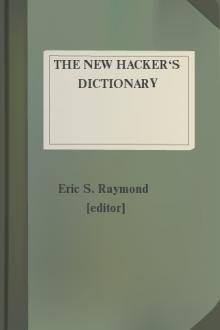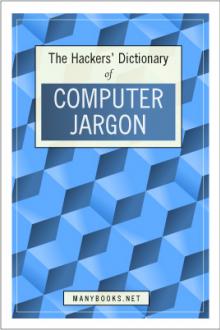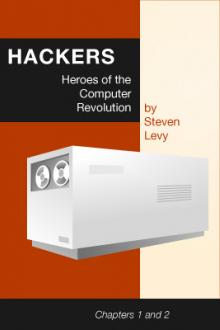The New Hacker's Dictionary by Eric S. Raymond (romantic novels to read .txt) 📕

- Author: Eric S. Raymond
- Performer: 0262680920
Book online «The New Hacker's Dictionary by Eric S. Raymond (romantic novels to read .txt) 📕». Author Eric S. Raymond
machine, especially sustained performance. "This box cranks (or,
cranks at) about 6 megaflops, with a burst mode of twice that on
vectorized operations."
Node:crapplet, Next:[3190]CrApTeX, Previous:[3191]crank, Up:[3192]= C
=
crapplet n.
[portmanteau, crap + applet] A worthless applet, esp. a Java widget
attached to a web page that doesn't work or even crashes your browser.
Also spelled `craplet'.
Node:CrApTeX, Next:[3193]crash, Previous:[3194]crapplet, Up:[3195]= C
=
CrApTeX /krap'tekh/ n.
[University of York, England] Term of abuse used to describe TeX and
LaTeX when they don't work (when used by TeXhackers), or all the time
(by everyone else). The non-TeX-enthusiasts generally dislike it
because it is more verbose than other formatters (e.g. [3196]troff)
and because (particularly if the standard Computer Modern fonts are
used) it generates vast output files. See [3197]religious issues,
[3198]TeX.
Node:crash, Next:[3199]crash and burn, Previous:[3200]CrApTeX,
Up:[3201]= C =
crash
n. A sudden, usually drastic failure. Most often said of the[3202]system (q.v., sense 1), esp. of magnetic disk drives (the term
originally described what happens when the air gap of a hard disk
collapses). "Three [3203]lusers lost their files in last night's disk
crash." A disk crash that involves the read/write heads dropping onto
the surface of the disks and scraping off the oxide may also be
referred to as a head crash', whereas the termsystem crash'
usually, though not always, implies that the operating system or other
software was at fault. 2. v. To fail suddenly. "Has the system just
crashed?" "Something crashed the OS!" See [3204]down. Also used
transitively to indicate the cause of the crash (usually a person or a
program, or both). "Those idiots playing [3205]SPACEWAR crashed the
system." 3. vi. Sometimes said of people hitting the sack after a long
[3206]hacking run; see [3207]gronk out.
Node:crash and burn, Next:[3208]crawling horror, Previous:[3209]crash,
Up:[3210]= C =
crash and burn vi.,n.
A spectacular crash, in the mode of the conclusion of the car-chase
scene in the movie "Bullitt" and many subsequent imitators (compare
[3211]die horribly). Sun-3 monitors losing the flyback transformer and
lightning strikes on VAX-11/780 backplanes are notable crash and burn
generators. The construction `crash-and-burn machine' is reported for
a computer used exclusively for alpha or [3212]beta testing, or
reproducing bugs (i.e., not for development). The implication is that
it wouldn't be such a disaster if that machine crashed, since only the
testers would be inconvenienced.
Node:crawling horror, Next:[3213]cray, Previous:[3214]crash and burn,
Up:[3215]= C =
crawling horror n.
Ancient crufty hardware or software that is kept obstinately alive by
forces beyond the control of the hackers at a site. Like [3216]dusty
deck or [3217]gonkulator, but connotes that the thing described is not
just an irritation but an active menace to health and sanity. "Mostly
we code new stuff in C, but they pay us to maintain one big FORTRAN II
application from nineteen-sixty-X that's a real crawling horror...."
Compare [3218]WOMBAT.
Node:cray, Next:[3219]cray instability, Previous:[3220]crawling
horror, Up:[3221]= C =
cray /kray/ n.
(properly, capitalized) One of the line of supercomputers designedby Cray Research. 2. Any supercomputer at all. 3. The [3222]canonical
[3223]number-crunching machine.
The term is actually the lowercased last name of Seymour Cray, a noted
computer architect and co-founder of the company. Numerous vivid
legends surround him, some true and some admittedly invented by Cray
Research brass to shape their corporate culture and image.
Node:cray instability, Next:[3224]crayola, Previous:[3225]cray,
Up:[3226]= C =
cray instability n.
A shortcoming of a program or algorithm that manifests itself onlywhen a large problem is being run on a powerful machine (see
[3227]cray). Generally more subtle than bugs that can be detected in
smaller problems running on a workstation or mini. 2. More
specifically, a shortcoming of algorithms which are well behaved when
run on gentle floating point hardware (such as IEEE-standard or
PDP-series machines) but which break down badly when exposed to a
Cray's unique `rounding' rules.
Node:crayola, Next:[3228]crayola books, Previous:[3229]cray
instability, Up:[3230]= C =
crayola /kray-oh'l*/ n.
A super-mini or -micro computer that provides some reasonable
percentage of supercomputer performance for an unreasonably low price.
Might also be a [3231]killer micro.
Node:crayola books, Next:[3232]crayon, Previous:[3233]crayola,
Up:[3234]= C =
crayola books n.
The [3235]rainbow series of National Computer Security Center (NCSC)
computer security standards (see [3236]Orange Book). Usage: humorous
and/or disparaging.
Node:crayon, Next:[3237]creationism, Previous:[3238]crayola books,
Up:[3239]= C =
crayon n.
Someone who works on Cray supercomputers. More specifically, itimplies a programmer, probably of the CDC ilk, probably male, and
almost certainly wearing a tie (irrespective of gender). Systems types
who have a Unix background tend not to be described as crayons. 2.
Formerly, anyone who worked for Cray Research; since the buyout by
SGI, anyone they inherited from Cray. 3. A [3240]computron (sense 2)
that participates only in [3241]number-crunching. 4. A unit of
computational power equal to that of a single Cray-1. There is a
standard joke about this usage that derives from an old Crayola crayon
promotional gimmick: When you buy 64 crayons you get a free sharpener.
Node:creationism, Next:[3242]creep, Previous:[3243]crayon, Up:[3244]=
C =
creationism n.
The (false) belief that large, innovative software designs can be
completely specified in advance and then painlessly magicked out of
the void by the normal efforts of a team of normally talented
programmers. In fact, experience has shown repeatedly that good
designs arise only from evolutionary, exploratory interaction between
one (or at most a small handful of) exceptionally able designer(s) and
an active user population -- and that the first try at a big new idea
is always wrong. Unfortunately, because these truths don't fit the
planning models beloved of [3245]management, they are generally
ignored.
Node:creep, Next:[3246]creeping elegance, Previous:[3247]creationism,
Up:[3248]= C =
creep v.
To advance, grow, or multiply inexorably. In hackish usage this verb
has overtones of menace and silliness, evoking the creeping horrors of
low-budget monster movies.
Node:creeping elegance, Next:[3249]creeping featurism,
Previous:[3250]creep, Up:[3251]= C =
creeping elegance n.
Describes a tendency for parts of a design to become [3252]elegant
past the point of diminishing return, something which often happens at
the expense of the less interesting parts of the design, the schedule,
and other things deemed important in the [3253]Real World. See also
[3254]creeping featurism, [3255]second-system effect, [3256]tense.
Node:creeping featurism, Next:[3257]creeping featuritis,
Previous:[3258]creeping elegance, Up:[3259]= C =
creeping featurism /kree'ping fee'chr-izm/ n.
[common] 1. Describes a systematic tendency to load more [3260]chrome
and [3261]features onto systems at the expense of whatever elegance
they may have possessed when originally designed. See also
[3262]feeping creaturism. "You know, the main problem with [3263]BSD
Unix has always been creeping featurism." 2. More generally, the
tendency for anything complicated to become even more complicated
because people keep saying "Gee, it would be even better if it had
this feature too". (See [3264]feature.) The result is usually a
patchwork because it grew one ad-hoc step at a time, rather than being
planned. Planning is a lot of work, but it's easy to add just one
extra little feature to help someone ... and then another ... and
another.... When creeping featurism gets out of hand, it's like a
cancer. Usually this term is used to describe computer programs, but
it could also be said of the federal government, the IRS 1040 form,
and new cars. A similar phenomenon sometimes afflicts conscious
redesigns; see [3265]second-system effect. See also [3266]creeping
elegance.
Node:creeping featuritis, Next:[3267]cretin, Previous:[3268]creeping
featurism, Up:[3269]= C =
creeping featuritis /kree'ping fee'-chr-i:`t*s/ n.
Variant of [3270]creeping featurism, with its own spoonerization:
`feeping creaturitis'. Some people like to reserve this form for the
disease as it actually manifests in software or hardware, as opposed
to the lurking general tendency in designers' minds. (After all, -ism
means condition' orpursuit of', whereas -itis usually means
`inflammation of'.)
Node:cretin, Next:[3271]cretinous, Previous:[3272]creeping featuritis,
Up:[3273]= C =
cretin /kret'in/ or /kree'tn/ n.
Congenital [3274]loser; an obnoxious person; someone who can't do
anything right. It has been observed that many American hackers tend
to favor the British pronunciation /kret'in/ over standard American
/kree'tn/; it is thought this may be due to the insidious phonetic
influence of Monty Python's Flying Circus.
Node:cretinous, Next:[3275]crippleware, Previous:[3276]cretin,
Up:[3277]= C =
cretinous /kret'n-s/ or /kreet'n-s/ adj.
Wrong; stupid; non-functional; very poorly designed. Also used
pejoratively of people. See [3278]dread high-bit disease for an
example. Approximate synonyms: [3279]bletcherous, [3280]bagbiting
[3281]losing, [3282]brain-damaged.
Node:crippleware, Next:[3283]critical mass, Previous:[3284]cretinous,
Up:[3285]= C =
crippleware n.
[common] Software that has some important functionalitydeliberately removed, so as to entice potential users to pay for a
working version. 2. [Cambridge] Variety of [3286]guiltware that
exhorts you to donate to some charity (compare [3287]careware,
[3288]nagware). 3. Hardware deliberately crippled, which can be
upgraded to a more expensive model by a trivial change (e.g., cutting
a jumper).
An excellent example of crippleware (sense 3) is Intel's 486SX chip,
which is a standard 486DX chip with the co-processor diked out (in
some early versions it was present but disabled). To upgrade, you buy
a complete 486DX chip with working co-processor (its identity thinly
veiled by a different pinout) and plug it into the board's expansion
socket. It then disables the SX, which becomes a fancy power sink.
Don't you love Intel?
Node:critical mass, Next:[3289]crlf, Previous:[3290]crippleware,
Up:[3291]= C =
critical mass n.
In physics, the minimum amount of fissionable material required to
sustain a chain reaction. Of a software product, describes a condition
of the software such that fixing one bug introduces one plus
[3292]epsilon bugs. (This malady has many causes: [3293]creeping
featurism, ports to too many disparate environments, poor initial
design, etc.) When software achieves critical mass, it can never be
fixed; it can only be discarded and rewritten.
Node:crlf, Next:[3294]crock, Previous:[3295]critical mass, Up:[3296]=
C =
crlf /ker'lf/, sometimes /kru'lf/ or /C-R-L-F/ n.
(often capitalized as `CRLF') A carriage return (CR, ASCII 0001101)
followed by a line feed (LF, ASCII 0001010). More loosely, whatever it
takes to get you from the end of one line of text to the beginning of
the next line. See [3297]newline, [3298]terpri. Under [3299]Unix
influence this usage has become less common (Unix uses a bare line
feed as its `CRLF').
Node:crock, Next:[3300]cross-post, Previous:[3301]crlf, Up:[3302]= C =
crock n.
[from the American scatologism `crock of shit'] 1. An awkward feature
or programming technique that ought to be made cleaner. For example,
using small integers to represent error codes without the program
interpreting them to the user (as in, for example, Unix make(1), which
returns code 139 for a process that dies due to [3303]segfault). 2. A
technique that works acceptably, but which is quite prone to failure
if disturbed in the least. For example, a too-clever programmer might
write an assembler which mapped instruction mnemonics to numeric
opcodes algorithmically, a trick which depends far too intimately on
the particular bit patterns of the opcodes. (For another example of
programming with a dependence on actual opcode values, see [3304]The
Story of Mel in Appendix A.) Many crocks have a tightly woven, almost
completely unmodifiable structure. See [3305]kluge, [3306]brittle. The
adjectives crockish' andcrocky', and the nouns `crockishness' and
`crockitude', are also used.
Node:cross-post, Next:[3307]crossload, Previous:[3308]crock,
Up:[3309]= C =
cross-post vi.
[Usenet; very common] To post a single article simultaneously to
several newsgroups. Distinguished from posting the article repeatedly,
once to each newsgroup, which causes people to see it multiple times
(which is very bad form). Gratuitous cross-posting without a
Followup-To line directing responses to a single followup group is
frowned upon, as it tends to cause [3310]followup articles to go to
inappropriate newsgroups when people respond to only one part of the
original posting.
Node:crossload, Next:[3311]crudware, Previous:[3312]cross-post,
Up:[3313]= C =
crossload v.,n.
[proposed, by analogy with [3314]upload and [3315]download] To move
files between machines on a peer-to-peer network of nodes that act as
both servers and clients for a distributed file store. Esp.
appropriate for ananonymized networks like Gnutella and Freenet.
Node:crudware, Next:[3316]cruft, Previous:[3317]crossload, Up:[3318]=
C =
crudware /kruhd'weir/ n.
Pejorative term for





Comments (0)